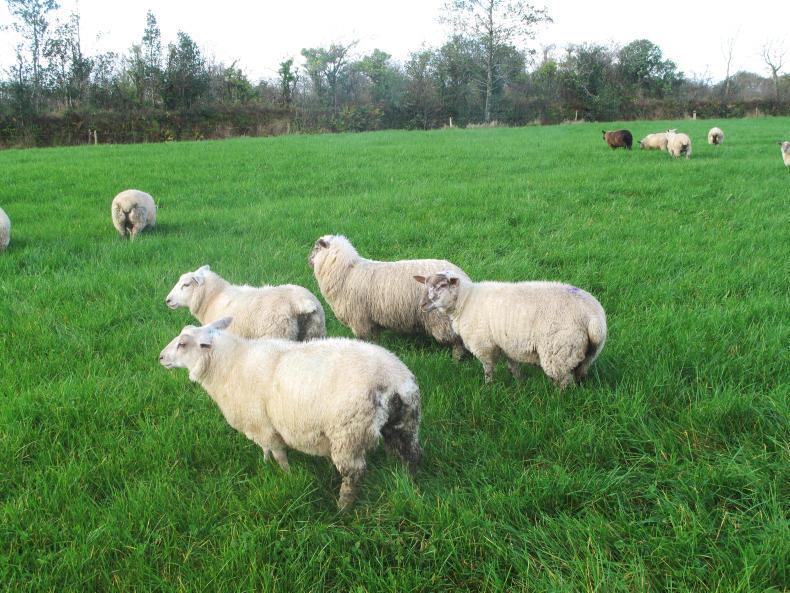The positive grass supplies on lowly stocked farms in particular and hesitation by some farmers to replace cattle drafted for slaughter has helped demand for store lambs, ewe lambs and feeding ewes in recent weeks.
However, the recent pressure on lamb prices has led to some farmers questioning the economics of the system and looking into the option of temporary grazing agreements.
These also came much more to the fore in 2018, with an increase in such agreements to facilitate grazing of forage crops.
Rules
It is important to note that there are rules governing the notification of movements and that these vary depending on the type of farm animals are moving to.
There are three main scenarios in which notifying the Department of movements differ and these are discussed below.
It is also important to remember that any sheep leaving the holding of origin must adhere to national sheep identification rules.
Since 1 June 2019, any sheep leaving a holding and moving farm to farm or to a mart or show, etc, must possess an electronic tag in its right ear and a matching conventional tag in its left ear.
1) Movement to lands with no stock
This is quite a common occurrence where sheep are moving to tillage farms to graze forage crops or after-grass swards.
It is also said to be occurring more this year on farms that normally cut hay and silage for sale, with low demand discouraging farmers to close ground for second cuts.
Where the movement is to a farm with no stock present, sheep can be moved to and from temporary grazing without dispatch documents and without notifying the Department.
2) Movement to farms where livestock are present
If sheep are moving to a holding where livestock are present, then the Department must be notified.
Unlike a permanent farm-to-farm movement, the onus lies on the owner of the sheep to notify the Department, as there is no change of ownership with the movement.
The Department can be notified by simply completing the dispatch document and sending the pink copy to your local district veterinary office.
When sheep return from temporary grazing, it can be completed by sending the white copy of the dispatch document clearly marked “return from temporary grazing”.
3) Movement to a detached land block on a livestock holding
A common exception to the above scenario is where sheep are moved to a holding that has livestock, but sheep are being moved to a separate land block to where the farmer’s animals are located.
In this case, sheep can be moved to a parcel or outfarm block without notifying the Department, provided there are no livestock on any part of the land sheep are being moved to.
There are other important aspects of temporary grazing agreements that also need to be discussed in light of the effect they can have on direct payments.
If lands are submitted on an applicant’s Basis Payment Scheme (BPS) application under the Areas of Natural Constraint (ANC), then lands cannot be rented to another party.
This is because the terms and conditions of the scheme state that in order for land to be deemed eligible for payment, the lands concerned must be available to the applicant for the full calendar year.
Land rented on an 11-month conacre system also must abide by the same rules, with the land under the control of the applicant that declares it on his/her BPS for the full 11 months.
However, this does not omit temporary grazing agreements and the BPS applicant taking in sheep for short-term grazing, as control of the land is not relinquished by the BPS/ANC applicant.
Such agreements work successfully, with costs involved generally agreed on a daily, weekly or monthly rate for grazing animals.
ANC stocking rate
Sheep coming on to the holding of the BPS/ANC applicant do not contribute to ANC stocking rate calculations, as there is no change of ownership.
The only exception to this is for bovines, where animals are moved under a contract-rearing agreement and the movement has been recorded through the Department’s Animal Identification and Movement (AIM) system for bovines.
It is not common, but, in some instances, the owner of the sheep may wish to gain nitrates credit for the organic nitrogen and phosphorus produced while sheep are on the temporary holding to reduce their annual production.
If so, and the movement is not recorded with your local DVO, then notice of the movement, using Record 4, Temporary Movement Form, must be sent to the DAFM nitrates section in Johnstown Castle, Wexford.
The last piece of advice concerns putting an agreement in place at the outset, so there is no fall-out at a later stage.
The most important area that raises conflict is the length of the grazing period, while other factors should include who is responsible for fencing.
Read more
Sheep management: store lamb budgets and grazing forage crops
The positive grass supplies on lowly stocked farms in particular and hesitation by some farmers to replace cattle drafted for slaughter has helped demand for store lambs, ewe lambs and feeding ewes in recent weeks.
However, the recent pressure on lamb prices has led to some farmers questioning the economics of the system and looking into the option of temporary grazing agreements.
These also came much more to the fore in 2018, with an increase in such agreements to facilitate grazing of forage crops.
Rules
It is important to note that there are rules governing the notification of movements and that these vary depending on the type of farm animals are moving to.
There are three main scenarios in which notifying the Department of movements differ and these are discussed below.
It is also important to remember that any sheep leaving the holding of origin must adhere to national sheep identification rules.
Since 1 June 2019, any sheep leaving a holding and moving farm to farm or to a mart or show, etc, must possess an electronic tag in its right ear and a matching conventional tag in its left ear.
1) Movement to lands with no stock
This is quite a common occurrence where sheep are moving to tillage farms to graze forage crops or after-grass swards.
It is also said to be occurring more this year on farms that normally cut hay and silage for sale, with low demand discouraging farmers to close ground for second cuts.
Where the movement is to a farm with no stock present, sheep can be moved to and from temporary grazing without dispatch documents and without notifying the Department.
2) Movement to farms where livestock are present
If sheep are moving to a holding where livestock are present, then the Department must be notified.
Unlike a permanent farm-to-farm movement, the onus lies on the owner of the sheep to notify the Department, as there is no change of ownership with the movement.
The Department can be notified by simply completing the dispatch document and sending the pink copy to your local district veterinary office.
When sheep return from temporary grazing, it can be completed by sending the white copy of the dispatch document clearly marked “return from temporary grazing”.
3) Movement to a detached land block on a livestock holding
A common exception to the above scenario is where sheep are moved to a holding that has livestock, but sheep are being moved to a separate land block to where the farmer’s animals are located.
In this case, sheep can be moved to a parcel or outfarm block without notifying the Department, provided there are no livestock on any part of the land sheep are being moved to.
There are other important aspects of temporary grazing agreements that also need to be discussed in light of the effect they can have on direct payments.
If lands are submitted on an applicant’s Basis Payment Scheme (BPS) application under the Areas of Natural Constraint (ANC), then lands cannot be rented to another party.
This is because the terms and conditions of the scheme state that in order for land to be deemed eligible for payment, the lands concerned must be available to the applicant for the full calendar year.
Land rented on an 11-month conacre system also must abide by the same rules, with the land under the control of the applicant that declares it on his/her BPS for the full 11 months.
However, this does not omit temporary grazing agreements and the BPS applicant taking in sheep for short-term grazing, as control of the land is not relinquished by the BPS/ANC applicant.
Such agreements work successfully, with costs involved generally agreed on a daily, weekly or monthly rate for grazing animals.
ANC stocking rate
Sheep coming on to the holding of the BPS/ANC applicant do not contribute to ANC stocking rate calculations, as there is no change of ownership.
The only exception to this is for bovines, where animals are moved under a contract-rearing agreement and the movement has been recorded through the Department’s Animal Identification and Movement (AIM) system for bovines.
It is not common, but, in some instances, the owner of the sheep may wish to gain nitrates credit for the organic nitrogen and phosphorus produced while sheep are on the temporary holding to reduce their annual production.
If so, and the movement is not recorded with your local DVO, then notice of the movement, using Record 4, Temporary Movement Form, must be sent to the DAFM nitrates section in Johnstown Castle, Wexford.
The last piece of advice concerns putting an agreement in place at the outset, so there is no fall-out at a later stage.
The most important area that raises conflict is the length of the grazing period, while other factors should include who is responsible for fencing.
Read more
Sheep management: store lamb budgets and grazing forage crops









SHARING OPTIONS